Once I’d tasted a number of Sriracha chile sauces from Thailand, the U.S., and Vietnam, I wondered if I could make my own. Why make it yourself when Sriracha costs less than $3 a bottle? I wanted to understand how the flavor of Sriracha came together. Additionally, I wondered if I could use readily available ingredients to make an excellent homemade version of the hot sauce? Huy Fong’s Rooster brand of Sriracha employs American ingredients so why can’t I?
My aim was to come close to replicating the nuanced and well-balanced Thai Shark brand of Sriracha, which my friends and I all gravitated toward liking during the Sriracha taste off. The ingredients listed on the Shark bottle were pretty straightforward: chiles, vinegar, garlic, sugar, and salt. (No preservatives please!) Most Thais buy Sriracha so there aren’t many published recipes, especially in English. However, I remembered tasting Chef Robert Danhi’s version of Sriracha that he made from scratch. I looked in his densely packed cookbook,Southeast Asian Flavors, and found it on page 133. Robert’s Sriracha recipe came in two versions: quick (I call it fresh here) and fermented. He’d researched it from going to the actual town of Sri Racha in Thailand and analyzing both Thai and American sauces. I tried both of Robert’s versions.
What kind of chiles to use?
Robert called for using Holland (long) chiles, a medium-hot, medium-large pepper similar to what is used in Thailand. Those chiles are not readily available in California, but I’d learned from James Oseland’s Cradle of Flavor, a fabulous cookbook on Malaysian, Singaporean, and Indonesian food, that Fresno chiles are a fine substitute for Holland (long) chiles. Available at my local Santa Cruz markets as well as Whole Foods, Fresnos are about the size of jalapenos; they are often mislabeled ‘red jalapeno’ at supermarkets. The pointy tip red chiles can be medium to medium-hot, depending on the time of year. So I found the most beautiful ones and bought about 3 pounds of them. Recipe development requires large quantities of things as you gotta make several batches to get things just right.
[July 26 update: I found green and red Holland (long) chiles at Ralph's Supermarket in while visiting my parents in San Clemente in Southern California.]
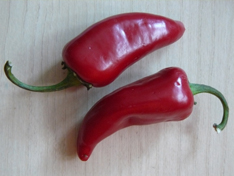
You could try red jalapenos like the Huy Fong Rooster brand of Sriracha; wait for late August or early September for those to arrive at farmer’s markets. You could also blend chiles like I did for making Vietnamese chile garlic sauce (tuong ot toi Viet Nam), using some Thai or habanero with the Fresno or cayenne, for example. See the September issue of Saveur magazine (I just got an advance copy; it has a burger on the cover) for Latin American food expert Maricel Presilla’s wonderful piece on growing chiles at home and the 4 page glossary of chiles that she cultivates.
Fish sauce and sugar
The recipe from Southeast Asian Flavors called for fish sauce and granulated sugar. Because none of the commercially made Sriracha sauces included fish sauce, I omitted it. I’m sure Robert added a dash of nuoc mam for umami savoriness. As for the granulated sugar, I imagine that the Thai producers of Shark brand used local palm sugar, which has a lovely round sweetness that’s not cloying. I tried batches made with regular white sugar and palm sugar and the palm sugar was tad better tasting. Below is the Thai palm sugar that I used:
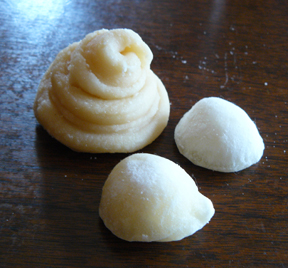
Thai palm sugar is not dark in color and molassy like its Malay and Indonesian gula Melaka or gula Jawa counterparts. Purchase the sugar from Chinese, Vietnamese, and Thai markets. Chop up the sugar with a heavy knife before using it so it dissolves easily. If palm sugar is unavailable, use light brown sugar. Dark brown sugar may darken the sauce more than you like.
Snip the Stem
Robert Danhi had an interesting tip for the chiles: Snip the stem but leave the star-like ‘crown’ part of the stem. Leaving the crown, Robert says, contributes floral qualities to the sauce. Here’s what he means:
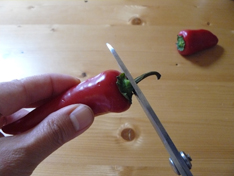
Other than that, making Sriracha hot sauce is a no-brainer. It’s so much brighter tasting than most store bought, remarkably tasty and you can personalize it to your taste buds! One friend, Victor Fong, doesn’t usually like spicy hot flavors, but he couldn’t stop eating the homemade Sriracha and treated it practically like ketchup. We made grilled cheese sandwiches last night for dinner and another friend Alec Mitchell slapped some homemade Sriracha on the bread instead of mustard. It was the best sandwich of the night.
Which is better: Fresh or Fermented Sriracha?
After several rounds of tasting, the fermented version came out ahead. It’s got more depth than the faster fresh version but it also takes several days to ferment. Since it takes so little to make this stuff, why not make both and do a taste off of your own? Then report back to us all here!
RECIPES
Fermented Sriracha Chile Sauce
Less garlic is used here versus in the fresh version because the fermentation accentuates the garlic flavor too much. On my first round of tastings with Pim and David Kinch, we all found that using the same quantity of garlic as the fast version produced a jolting, unpleasant garlicky kick.
Makes 1 ¼ cups
¾ pounds Fresno, Holland (long), Jalapeno or Cayenne chiles, snipped, halved lengthwise and coarsely chopped
2 cloves garlic
1 ¼ teaspoons kosher salt
2 ounces (2 tablespoons) Thai or Vietnamese palm sugar, or 1 tablespoon light brown sugar
¼ cup distilled white vinegar
Water, as needed
1. Combine the chiles, garlic, salt, and sugar in a food processor and chop finely to a texture like that of wet oatmeal. Transfer the mixture to a glass bowl or jar and cover with plastic wrap. Set aside at room temperature for 3 to 4 days, until small bubbles have formed under the surface of the mixture. If a little fuzzy mold forms, lift it off with a fork or knife and discard.
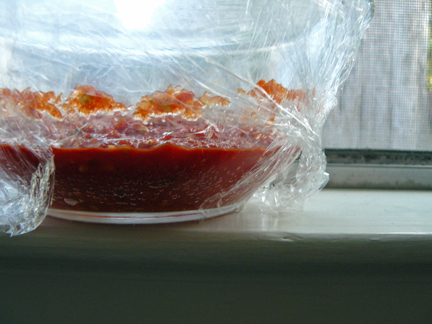
2. Put the fermented mixture and vinegar into small saucepan. Bring to a boil, then lower the heat to simmer for 5 minutes.
3. Remove from the heat and set aside to cool to room temperature. Transfer to a blender and puree for about 3 minute, until a smooth, orange-red mixture forms. Add the water to facilitate the pureeing, if needed.
4. Position a fine mesh strainer over a clean bowl. Then pass the chile sauce through, pressing on the solids with a spatula or spoon to extract as much chile sauce as possible. The mixture is often slightly too thick for me so I’ll stir 1 tablespoon of water into the finished chile sauce. Let the flavor develop and bloom for a few hours before using. Taste it and make any flavor adjustment with salt, sugar or vinegar. Store in a jar and keep refrigerated for 1 month. Bring it to room temperature before using.
Fresh Sriracha Chile Sauce
This quick version of Srirach comes together in a jiffy and is extra terrific when you’re in a pinch. With the extra garlic, I prefer an extra kick from the sugar. On the first time out, start with the smaller quantity and work your way up to tinker with the flavor. Because this version is fast to prepare, you can also make half batches and play with the flavors that way too.
Makes 1 ½ cups
¾ pounds Fresno, Holland (long) or Cayenne chiles, snipped, halved lengthwise and coarsely chopped
4 cloves garlic
1 ¼ teaspoons kosher salt
2 to 3 ounces (1 ½ to 3 tablespoons) Thai or Vietnamese palm sugar, or 1 ½ to 2 tablespoon light brown sugar
¼ cup distilled white vinegar
½ cup water
1.Put the chiles, garlic, salt, sugar, vinegar and water in small saucepan. Bring to a boil over high heat, then lower the heat to vigorously simmer for 5 minutes. Remove from heat and set aside to cool to room temperature.
2. Transfer to a blender and puree for about 5 minutes, until a smooth, orange-red mixture forms. Add water by the teaspoon to facilitate the pureeing, if needed.
3. Position a fine mesh strainer over a clean bowl. Then pass the chile sauce through, pressing on the solids with a spatula or spoon to extract as much chile sauce as possible. If the mixture is too thick, stir in water by the tablespoon of water. Let the flavor develop and bloom for a few hours before using. Taste it and make any flavor adjustment with salt, sugar or vinegar. Store in a jar and keep refrigerated for 1 month. Bring it to room temperature before using.
Notes: Recipes adapted from Robert Danhi's Southeast Asian Flavors (Mortar & Press, 2008)
Related recipe links:













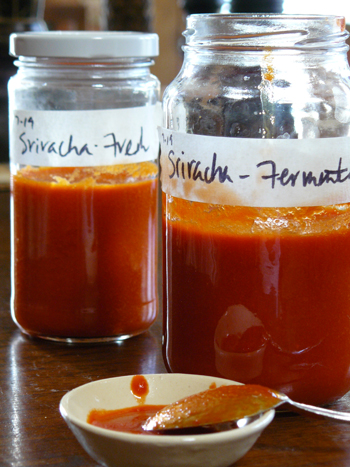




OysterCulture says
Looks fantastic, love the store bought so can only imagine how much better the homemade will taste!
fred says
Since summer is upon us, do you think the sauce should be canned/bottled using a water bath or do you think just a sterile jars would work?
Andrea Nguyen says
Fred -- How'd you read my mind? I was just thinking about canning the sauce. If I were to can the sauce for long-term keeping, I'd do the sterile jar and water bath thing. Most Asian cooks don't do that because the notion is that you pickle and preserve as you go!
But to use up all the summer's bounty of red chiles, I'd do a regular canning method. Or, freeze the sauce in plastic containers or zip-top bags.
If you go any of these routes, PLEASE do me the favor of letting me know how it goes!
diana says
i'd love to make it...however, is it hot? if so, can i use milder peppers? and if so, what kind would they be.
Andrea Nguyen says
Diana, the flavor is mildly hot from this recipe because the chiles used are not searing like the small Thai chiles. You eat the homemade Sriracha and you say, "Hey, I can keep eating this." If the sauce is too hot for your palate, you can tone it down with some sugar and/or water!
[email protected] says
Thanks for taking the time Andrea to get into the spicy condiments I love so much. In Thailand they do traditionally add fish sauce - not by approach yet what I saw was most common.
Andrea Nguyen says
You're welcome Robert! Love making Sriracha from California ingredients. If there are Thais who put nam pla in their Sriracha, why don't the commercial brands?
LowerEastSider says
I recently made a sriracha using red fresnos. it cam out great. I first cooked all the chilies and garlic in the wok to give it a little char flavor. Blneded everything up , sugar, salt and rice vinegar. I wanted to add a little something extra though for thickness. two heaping tablespoons of korean chili paste. passed all through a chinoise and it was really something. the wok char came through and added another dimension.
Andrea Nguyen says
I like your approach, LowerEastSider. Very nice touch of char would lend depth. Brilliant!
Stephen Brandt says
This is very well done. I have a batch fermenting using red Cayenne chiles, which I am looking forward to enjoying! Of the chilis you mention, which, do you think, works the best? Thank you very much.
Andrea Nguyen says
Thank you, Stephen. You want a moderate or moderately hot chile so cayenne, long (Holland) or Fresno closely approximates the chile used in Thailand. However, chiles vary in heat during the year so you have to finesse it, even blending the chiles, if you want. However, you can always tweak the Sriracha in the end.
Luci Cook says
I use Huy Fong's sriracha on EVERYTHING. Tons of it! I was recently put on a low salt diet and was saddened to see it had so much sodium in it (preservation). So I was happy to try this (lower salt) recipe. I am on the 4th day of preparing my sauce, and I used 1 lb serrano and one habanero chile just to experiment, but it hasn't formed bubbles. Could it be due to the different peppers, and if it doesn't ferment, should I start over?
Andrea Nguyen says
Luci -- it may be a matter of the winter temps. I wouldn't throw it away --- cook it and see what happens. Sometimes there are no bubbles then all of a sudden they appear! I made the Sriracha during the warmer months in Northern California. You may see little mounds on the surface as the fermentation pushes up the mixture. That's fermentation happening. As a precaution, remove any mold that may form.
coach sale says
We must have the patience to do anything, For example we learning English, we muat Relax! Be patient and enjoy ourseves. Learning foreign languages should be fun.!
vegetarian recipes says
Very Good Recipe I Must Try This Sauce Recipe Out
Arturo says
BTW minor correction: 2 ounces = 4 tablespoons
I am trying the fermented version, looking forward to trying it in a few days. I have added 10 dried chile de arbol for a little extra heat.
L Gumaer says
Would you advise using a rice wine vinegar as opposed to just white distilled vinegar?
Thank you, lGumaer
JChrisnter says
Excellent ideas! I never thought to make my own.
Air Jordans says
To conclude this endless pain
chaussure de basket says
Life is tough, we must be stronger*_*
Cheap Shoes says
The greatest lesson in life is to know that even fools are right sometimes.
Coach Shoes says
There's no longer a missing, A friend will no longer lonely, About to have a permanent cold warm, Let's have a kind of love I met you in space.
WalterBC says
merci afin de cette nouvelle, un note pertinent total et enfin super.
RobertMC says
merci pour cette nouvelle, un périodique utile rapide et complet mais aussi super.
FPMichael says
merci pour cette nouvelle, un périodique pratique rapide mais super.
FPMichael says
merci afin de cette nouvelle, un chronique pratique rapide d'ailleurs , super.
Rosa Fernandez says
Hello, I know this is a long post, but was looking for a recipe to make my own healthier sriracha at home.
Thanks for the recipe, will try it, but on the fermented recipe, aren't you killing the good bugs by cooking it? wouldn't that be defeting (did I spell it right?) the purpose of the fermentation?
Will try it and not cook it and see how it tastes, or maybe cook it first and then let it ferment by inoculating it with kefir whey?
ClubPenguinCheats says
If I were to can the sauce for long-term keeping, I'd do the sterile jar and water bath thing.
birkenstock outlet says
So fun article is! I agree the idea!
Chris says
Thanks so much for the recipes and the comparison! I just finished making a fermented version and love it - as does everybody at the office. For the next batch, I plan to double the garlic and halve the vinegar. It's so much fun to fine tune things like this.
Also, a word to the wise...don't throw away the mash after straining in the final step. It makes a great base for a quick red curry as I did here (with organic ingredients as available):
- 2 tbs grape seed oil (or whichever high-heat vegetable oil you prefer)
- 1 clove garlic, chopped
- 1/2 head cauliflower
- 1 red bell pepper
- 1 yellow squash
- 1/2c light coconut milk
- 1 handful torn basil
- 1 kefir lime leaf
- 1/4c to all remaining sriracha chili mash (depending on how hot you want your curry - I used it all and it turned out fantastic)
1. Break the cauliflower into small florets and chop red bell pepper and squash into similarly sized pieces.
2. Heat oil in wok over medium-high heat until shimmering.
3. Add garlic and kefir lime to wok and fry for 30 seconds or so, taking care the garlic does not burn.
4. Add sriracha mash to wok and fry for 1 minute, making sure to stir continually.
5. Add cauliflower to wok and fry for 3 minutes.
6. Add squash and red bell pepper and fry for 1 minute.
7. Add coconut milk, and reduce heat to medium.
8. Cover and simmer until cauliflower reaches your preferred doneness. I like mine to still have a little bit of a bite.
9. Turn off heat, add torn basil and toss.
Serve hot over your favorite rice. (If you happen to have the kefir leaves on hand, toss in a couple with your rice as it cooks for some wonderfully scented rice.)
Thanks again, Andrea!
Assistance says
OMG that is extraordinary! I love your work! Guess I am not as contemporaneous as your usual fans! I swear I have fallen in love with your blog... Terrific writing! You're an amazingly talented person, keep up the individuality 🙂
Canada Goose Jakker says
There is a general debate nowadays about the problem of itinerant workers . Those who object to the rising migrant population argue that increasing numbers lead to rising crime rates and harm social stability . They believe that strict limits should be placed on migrants entering China ' s cities . But people who favor the influx of the cheap labor force , on the other hand , maintain that migrants are needed to support the massive urban infrastructure construction program .
Christian Louboutin says
Two ears to one tongue, therefore hear twice as much as you speak.
Saj San says
great page. i like this sauce but not too much sugar. Try also garlic peri-peri; it is a great complement to this.
keet says
Just about out of the 1st batch of fermented sriracha. Stopped by the market today and picked up a lb of Fresnos. After chopping they were not hot enough so I added a heaping tablespoon of dry red habanero flakes.
kinh mat thoi trang says
Sriracha has proved relevant beyond the epicurean realm. Wal-Mart sells the stuff. So do mom-and-pop stores, from Bristol, Tenn., to Bisbee, Ariz.
Sriracha is a key ingredient in street food: The two Kogi trucks that travel the streets of Los Angeles, vending kimchi-garnished tacos to the young, hip and hungry, provide customers with just one condiment, Huy Fong sriracha.
russian dating site says
Robert’s Sriracha recipe came in two versions: quick (I call it fresh here) and fermented. He’d researched it from going to the actual town of Sri Racha in Thailand and analyzing both Thai and American sauces. I tried both of Robert’s versions.
chose girls from ukraine and russia says
Just about out of the 1st batch of fermented sriracha. Stopped by the market today and picked up a lb of Fresnos. After chopping they were not hot enough so I added a heaping tablespoon of dry red habanero flakes.
Elijah Wood says
Diana, the flavor is mildly hot from this recipe because the chiles used are not searing like the small Thai chiles. You eat the homemade Sriracha and you say, "Hey, I can keep eating this." If the sauce is too hot for your palate, you can tone it down with some sugar and/or water!
marlon says
The greatest lesson in life is to know that even fools are right sometimes.
marlon says
This is very well done. I have a batch fermenting using red Cayenne chiles, which I am looking forward to enjoying!
Chaussure de Foot says
it must be tasty, i always make some sauce by myself at my home! thank u for your post that we can share some experiences with u !
murph says
I wonder if regular/unsweetened rice vinegar could be substituted for white vinegar?
Andrew says
Just a note, if you like things a little spicy, I make this sauce once a week (I swear!) and add 2 habaneros, with seeds, to the rest of the peppers. Makes a perfect spicy sriracha. I guesss it could depend on whether the Fresno's I'm getting in the first place are too mild.
scott says
have made many variations of this in the Sweetwater Spice Co. kitchen - great recipes.
MikeS says
Hi Andrea, Thank you for the recipe. I made this in Nov. in the UK with EXTREMELY limited choice of chiles. I used Sotch Bonnet, Cayenne and a fat, long sweet chile from 3 Bangladeshi grocers.
I think I overdid the Garlic but its still pretty good.
Kelly says
I just made a double batch of the fresh version and used 1 pound red jalapeños and 1/2 pound seranos because the peppers in the recipe weren't available at my grocery store. It turned out absolutely incredible!!! The heat index was almost identical to the bottled version but the depth and flavor was unsurpassable. Absolutely amazing and so easy. I am now a sriracha snob and won't be able to return to the bottle. So sooo good. Thanks for the recipe!
Wayne says
Would a person be able to use yellow habernero chillis?
charles says
For the "fresh" I would suggest steaming the chilies etc. I have actually not made sriracha, but I make a red salsa out of those red chilis you bought at ralphs with garlic, and, ironically enough, i use sriracha sauce to spice it up. Anyway, steaming i feel is the way to go with those chilis 🙂
Rodrigo Duarte says
Thanks for the recipe.
We prepare our own Sriracha, as we have not found it in stores here in Ecuador. The tip about leaving the crown on the chillies definitely piqued our interest. The sauce is now boiling softly.
Thanks again!
Lisa C Goldman says
I accidentally planted Thai red peppers (those tiny ones) instead of Fresnos. Now I have a million of these Thai peppers. If I try to use them in this recipe, will it be way too hot? Is there anything I can do to tone it down?
Andrea Nguyen says
Add sugar. But sometimes the chiles are not as hot as you think. Mine when ripened to a red state are moderately hot.